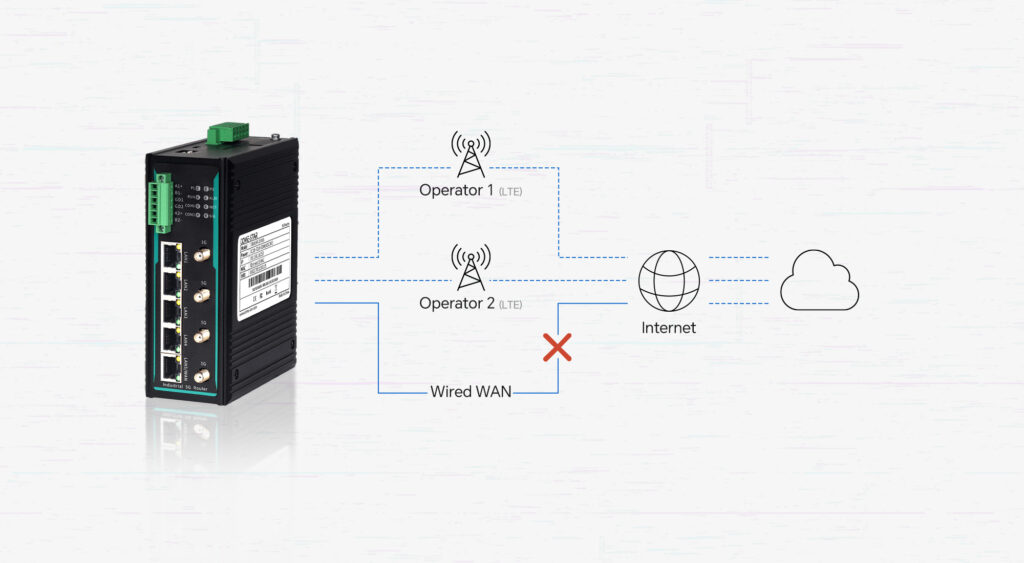In today’s era of rapid digitalization and automation, network “stability” has become a necessity for both production and daily life. For businesses, a single network outage could mean failed transactions, lost customers, or even production interruptions and equipment downtime. In such scenarios, a “failover router” with automatic switching capabilities becomes particularly critical. It is not only a core component for ensuring uninterrupted business operations but is also widely applied in various fields such as industrial internet, smart offices, and remote communication, serving as a cornerstone of high-availability network architectures.
Failover Routers: The “Intelligent Hub” of Network Redundancy
A failover router is essentially an industrial-grade communication device with redundant link management capabilities. Traditional industrial routers only handle single network access and data forwarding tasks, while failover routers go a step further by incorporating multiple WAN ports (wide area network interfaces) and intelligent switching algorithms. In an industrial environment, for example, when the primary link (such as a wired fiber-optic connection) becomes disconnected due to equipment failure, natural disasters, or human damage, the failover router can immediately detect the network anomaly and automatically switch data traffic to a backup link, such as a 4G/5G cellular network or another wired broadband connection. The entire switching process requires no manual intervention, ensuring a seamless transition of network connectivity.
Core Features of Failover Routers
Router Compatibility and Failover Configuration Capabilities
Not all WiFi routers have failover capabilities. When selecting a product, it is essential to prioritize devices that explicitly support failover mechanisms or can enable this feature through firmware upgrades. This typically includes models with multiple WAN ports, cellular network access, or USB expansion interfaces, which can provide backup paths and enable rapid automatic switching.
Automatic failover vs. manual failover
Failover is divided into automatic and manual modes.
Automatic failover routers continuously monitor the status of the primary network connection. When an interruption is detected, the system immediately switches to the backup connection without requiring manual intervention, ensuring business continuity. This feature is especially critical in mission-driven environments like emergency medical services, where even a few seconds of downtime can impact lives. A good example of this is found in 5G connected ambulances, where dual-SIM industrial routers with automatic failover maintain real-time data transmission for patient monitoring, live video, and GPS—even in remote areas without fixed network coverage.
Manual failover requires administrators to manually execute the switch operation after a network issue occurs. This method carries the risk of response delays and is not suitable for critical mission scenarios.
Key Features of an Automatic Failover Router
Easy Integration
A high-quality failover router should support plug-and-play functionality, making it easy to integrate into existing network architectures without requiring extensive network restructuring to deploy failover strategies. This makes it ideal for rapid deployment in enterprise and industrial environments.
Wide Connectivity Compatibility
The device should support multiple access methods, including Ethernet, 4G/5G cellular networks, USB modems, etc., and seamlessly integrate with mainstream operator networks to ensure stable and uninterrupted network switching.
Security Design
High-reliability routers typically integrate security features such as VPN encrypted transmission, built-in firewalls, and intrusion detection and prevention systems (IDS/IPS) to prevent data leaks and unauthorized access, ensuring communication security during failover processes.
Core Functions of Failover Routers
Dual WAN Support
Routers with dual WAN port design can connect to two different network lines simultaneously. If the primary line fails, the backup network is immediately activated, enhancing overall network redundancy and bandwidth utilization efficiency.
Load Balancing Function
In addition to failover, some high-end routers support dual WAN load balancing, intelligently distributing data traffic across different networks to improve bandwidth utilization, alleviate network congestion, and enhance overall communication quality.
VPN Support
Failover routers supporting protocols such as L2TP/IPSec/OpenVPN can maintain encrypted tunnels without disconnecting during network switches, making them particularly suitable for scenarios with high security requirements, such as remote work, branch connectivity, and industrial remote monitoring.
Firewall and Network Isolation Features
Built-in firewalls and network segmentation capabilities help prevent unauthorized access while isolating guest networks from primary business networks, ensuring network structure security and clarity during failover processes.

Best Failover Router Recommendations
After understanding the definition and importance of failover routers, as well as the features that a high-quality failover router should have, here are our specific recommendations:
| Router model | WAN port | LAN port | Dual SIM card dual standby | VPN support (protocol) | Firewall and network isolation function support |
| CIR885R-2D485 | 1 x 10/100/1000 Mbps | 4 x 10/100/1000 Mbps | Support | PPTP/L2TP/GRE/GRETAP/TUN/TAP | support |
| CIR885R-2D232 | 1 x 10/100/1000 Mbps | 4 x 10/100/1000 Mbps | Support | PPTP/L2TP/GRE/GRETAP/TUN/TAP | support |
| CIR775-WB | 1 x 10/100 Mbps | 4 x 10/100 Mbps | Support | PPTP/L2TP/GRE/TUN/TAP | support |
Conclusion
Failover routers act as the “guardians” of industrial networks, providing robust network protection for critical business operations through the integration of multiple network technologies and intelligent switching mechanisms. Whether it is the digital transformation of traditional manufacturing industries or innovative applications in emerging fields, such devices will become an important support for improving network reliability and promoting industrial upgrading.


